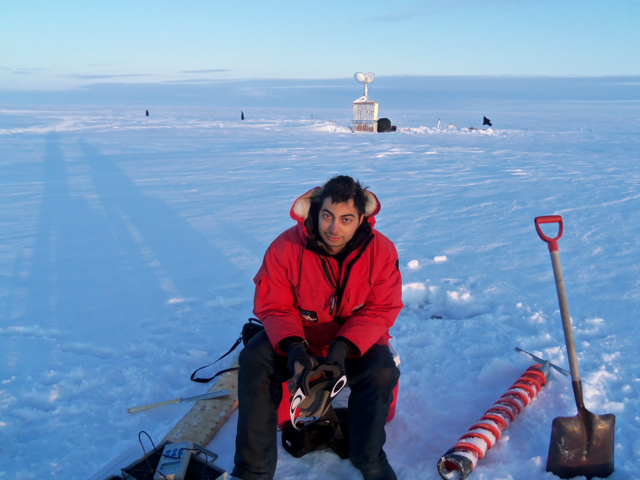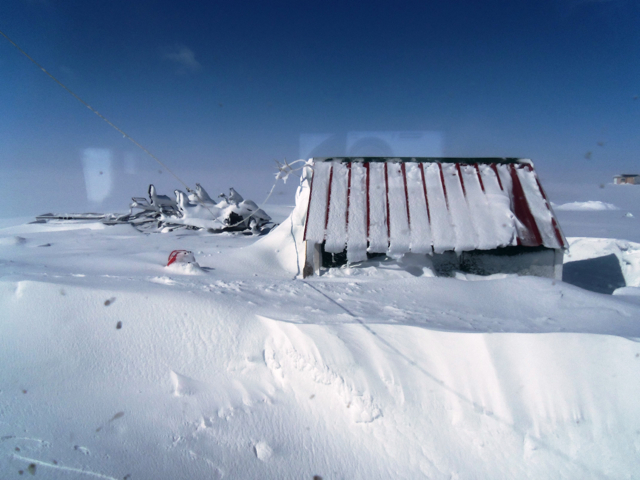A memorable first field experience in the Arctic!
A memorable first field experience in the Arctic!
It’s 5 a.m. and I’m sitting in Winnipeg Airport, wearing heavy-duty jacket and boots while everyone else is in shorts and sandals! I’m off to Edmonton and then Yellowknife and finally Cambridge Bay, Nunavut. It will be my very first time crossing the Arctic Circle and though, I’ve studied and talked about it to many colleagues, it is still hard to avoid this mixed feeling of nervous anticipation and sheer excitement. I will ater be accompanied by Alex Komorov (CEOS); we are going to work closely together for the next month.
After a rough flight, we finally arrive in Cambridge Bay. The town is much more developed than I expected. Temperature is not comparable to the brutal cold of SERF in January in Winnipeg. We get on a ski-doo and we head towards our temporarily resident in the CHARS government house within the town. Later, we move to the cabin by the frozen sea. We will do our measurements some 6 kilometers away from the cabin on the sea ice. It is amazing how quickly you get used to the ICE-CAMP lifestyle: taking turns to cook, early mornings, sleeping under a window that is always bright even at 3 a.m., working hard for 16 hours a day, no conventional washroom, etc. And yet strangely, I feel very comfortable here; I really enjoy the tranquility at the cabin and the company of my cabin-mates. Here we are away and focused on our science.
Alex and I are going to use a C-band scatterometers to measure the scattered wave off the snow-covered sea ice in a time-series fashion occasionally using the whole frequency band. For our measurement, we need to build a platform that is stable and provides the scatterometer antenna with a minimum height needed for our measurement objectives. I remember months of discussion over our platform design, something we both have a great faith in. Now it’s action time. Building the platform proved to be the easy task! Now we are stuck in a trouble-shooting loop: everyday, a new issue, a new error. But I have to admit, the pleasure of solving these issues each time is truly rewarding. More than a week of trouble-shooting and we finally get the scatterometers to work and it works beautifully: high quality data. We are doing time-series measurement requiring physical sampling of snow and ice three times a day, including temperature profiling. Samples are later processed for density and salinity so that we can find the permittivity of snow and ice to use in our models.

Nariman Firoozy (CEOS) at the snow and ice sampling site. Scatterometer in the background. Credit: Nariman Firoozy
The cabin is shaking. It’s 3 a.m. There is a storm with very intense wind. I wake up in a great fear, for our equipment at measuring site. Later in the morning and we are still trapped inside. The flame in the old furnace blows out and we are cold. We have little food and drinking water. Finally wind dies out and we get a chance to retrieve a snowmobile buried in snow. Alex and I drive to the site carefully and slowly. Finally from a distance, I see our platform, I keep looking, and it gets bigger and bigger. YES! It looks perfectly fine. We check it out. To our surprise it not move even a millimetre. I take pride in our design. We head back to the cabin.

The morning after the snow storm - view from Cabin window. Credit: Nariman Firoozy (CEOS)
Last day at Cambridge Bay, I took a shower after two weeks and went for a walk around the town with Alex and Catherine. Souvenir items in the shops are far too expensive for a student budget so we take a couple of photos instead. Later I’m sitting in the airplane back home and going through my memories of life and science at the camp. This trip taught me a lot - not only about the real Arctic (outside the scope of the papers in the literature) including priceless information I picked up during chats over dinner with colleagues, but also new discoveries about myself including my week points and my strong points. It sounds strange to some of my friends back home but I am already thinking about my next trip to the Arctic.
Submitted by: Nariman Firoozy, PhD candidate (CEOS, University of Manitoba)
June 28, 2014





